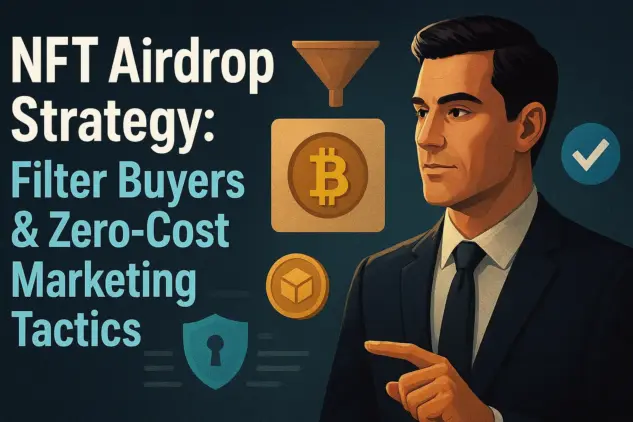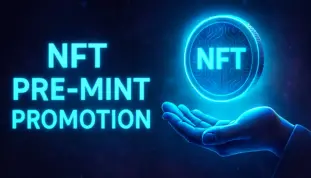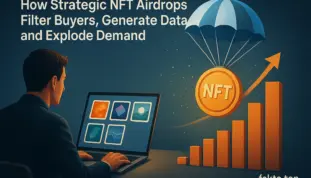Zero-Cost NFT Airdrop Strategy: Filter Buyers & Secure Diamond Hands
Zero-Cost NFT Airdrops to Filter Buyers
Let’s be honest: most NFT airdrops today are nothing more than noise. Wallets fill up, hype spikes, and floor prices collapse the moment the first flippers hit the market. If you’re still thinking of distributing NFTs for free without a plan, you’re behind the curve. NFT airdrops are no longer simple giveaways—they are powerful tools to filter buyers, gather actionable insights, and drive long-term engagement.

The goal here is clear: shift your perspective from “giving away free NFTs” to “harvesting valuable data about potential long-term holders.” This approach demands patience, observation, and a willingness to look beyond the hype. Treat your airdrop like a flyer, and you’ll get flyer results. Treat it as a zero-cost sales funnel, and you’ll cultivate the kind of community that stabilizes floor prices and generates organic demand.
Section 1: Airdrops as a Pre-Mint Data Harvesting Tool
Wallet Activity Analysis: Spotting Flippers Before the Mint Phase
One of the most underestimated aspects of NFT pre-mint promotion is the ability to analyze wallet activity before your official mint. Observing transaction patterns, holding duration, and asset diversity allows you to identify who is genuinely invested versus who is just chasing quick flips. This early intelligence gives you a critical advantage: you can pre-emptively filter out wallets likely to dump immediately after mint.

It’s not just about counting wallets—it’s about understanding behavior. You want to identify holders who are in for the long term, those with Diamond Hands mentality, and who contribute positively to your ecosystem. This insight transforms airdrops from random distribution into a strategic filter for quality buyers.
Sybil Attack Prevention: Conditional Airdrops for Whitelist Funnels
Sybil attacks—where one person manipulates multiple wallets to claim free NFTs—can devastate your project. The solution is simple but often overlooked: conditional airdrops tied to eligibility criteria. By requiring participants to meet certain conditions—like holding previous project tokens, engaging in community activities, or passing verification steps—you can create a secure whitelist funnel that rewards genuine interest and filters out opportunists.
This step not only protects your project but also ensures your distribution targets real stakeholders who are aligned with your long-term goals. It’s about turning potential noise into measurable value.
Rewarding Measurable Engagement: Airdrops for Community Building
Airdrops can do more than distribute tokens—they can incentivize real participation. Tracking contributions on Discord, Twitter, or other platforms allows you to reward community members who actively engage and contribute value. This isn’t just social media vanity; it’s a strategic way to identify advocates and contributors before your mint.
Measured engagement means your airdrop doubles as a community-building exercise. Those who participate meaningfully are far more likely to support your project, promote it organically, and stick around through market fluctuations.
Pre-Sale Intelligence: Identifying True “Diamond Hands” Early
Finally, airdrops allow you to perform pre-sale intelligence. You can identify Diamond Hands before the mint, securing your core audience and ensuring that your project has a foundation of committed holders. This intelligence is subtle but powerful: by the time your main sale occurs, you already know which wallets will stabilize your floor price and which might create volatility.

In short, strategic NFT filtering through early airdrops is no longer optional for serious projects—it’s essential. Those who embrace this approach will build communities with longevity and resilience, while those who ignore it risk launching into chaos.
Section 2: Zero-Budget Tactics: The Three Pillars of a Profitable Airdrop
Tactic 1: The Token-Gated Airdrop (Leveraging Proven Holders)
One of the most underutilized strategies in NFT marketing zero budget campaigns is the token-gated airdrop. Here, you reward users who already hold specific NFTs—either from your previous projects or from reputable blue-chip collections. This tactic costs nothing in advertising and leverages existing trust within the community.
By restricting access to holders who have proven commitment, you automatically filter for wallets likely to contribute positively to your ecosystem. This isn’t just efficiency; it’s surgical selection. And if someone grumbles about exclusivity, remind them: exclusivity creates value.
Tactic 2: The Proof-of-Work Airdrop (Vetting Contributors)
The Proof-of-Work airdrop is perfect for projects that want to reward active, committed participants. Community members complete tasks—creating content, reporting bugs, or generating referrals—to earn airdrop eligibility. The cost isn’t ETH; it’s your time spent reviewing submissions and moderating entries. But the payoff is enormous: you uncover contributors who are genuinely invested in your project’s success.
This approach not only incentivizes quality participation but also identifies future advocates and micro-influencers within your community. The “Proof-of-Work” method turns the airdrop into a strategic vetting tool, ensuring that only engaged participants gain privileged access.
Tactic 3: The Token Barrier Airdrop (Using SBT or ERC-20 Tokens)
The Token Barrier airdrop is an advanced filtering mechanism that pre-qualifies participants without giving away the NFT itself. Typically, you airdrop a non-transferable token, such as a Soulbound Token (SBT) or an ERC-20 token, which grants access to a whitelist spot. This subtle tactic weeds out opportunistic flippers before they even reach your mint. It’s elegant, precise, and almost cost-free aside from thoughtful planning and smart contract setup.
This approach transforms airdrops into a data-driven filter. By using a Token Barrier, you create a verifiable pool of participants who have demonstrated commitment. The SBT acts as an immutable badge of eligibility, eliminating the possibility of resale or list farming. Essentially, it’s the next generation of pre-qualification for serious projects.
Section 3: Anatomy of a Strategic Airdrop
Not all airdrops are created equal. The following table compares the most common airdrop types, highlighting cost, target audience, and primary risks. Understanding this matrix is essential for strategic execution.
| Airdrop Type | Cost (Gas/Effort) | Target Buyer Filtered | Primary Risk |
|---|---|---|---|
| Random Wallets (Classic) | Low Gas, Low Effort | None (Pure Fluff/Noise) | Sybil Attacks, Immediate Dump |
| Whitelist Spot (Conditional) | Medium Effort (Verification) | Engaged Community Member | List Saturation, Low Conversion |
| Token-Gated (Specific Holders) | Low Effort, High Setup Cost | Proven “Diamond Hand” Holder | Small Audience, High Gas Cost for Claiming |
| Proof-of-Work (Content) | High Effort (Review/Moderation) | Core Contributor, Influencer | Subjectivity in Selection |
This comparison isn’t academic. Random wallet drops generate noise and flippers. Whitelist spots filter engagement but require careful vetting. Token-gated airdrops ensure quality but need technical setup. Proof-of-Work airdrops demand effort but cultivate core contributors who will evangelize your project long-term. Understanding these dynamics is the difference between launching chaos and launching with precision.
Section 4: Advanced Web3 Integration and Risk Management
Gas Optimization: Sending Transactions in Batches
Gas fees can sneak up and eat your budget if you’re not careful. Sending airdrops one by one works in theory, but in practice it can get expensive fast and frustrate people trying to claim. A smarter way? Group your transactions into batches so you can send hundreds at once. It might feel a little tricky at first, but this is key if you want to manage your funds well and keep your project looking professional.
Lots of teams just accept high gas as a fact of life, but it doesn’t have to be that way. Batching saves money, cuts down on failed claims, and shows your community that you actually care about their time and wallets. Done right, it’s a small move that makes a big difference—and proves you know your stuff.
Chain Selection: Optimizing Reach with Solana and Polygon
Choosing the right blockchain is critical. Ethereum may be the most popular, but for smaller or mid-tier projects, Solana or Polygon often provide better cost efficiency, faster confirmations, and broader accessibility. Lower fees and a growing user base make these chains ideal for NFT marketing zero budget campaigns where engagement and adoption matter more than prestige.
Chain selection also impacts your audience’s experience. High gas fees can discourage participation and create negative sentiment. Selecting the right ecosystem ensures your airdrops are accessible, efficient, and targeted at wallets most likely to hold long-term.
What Keeps Founders Up at Night (Risk & Credibility)
Even experienced founders stumble from time to time—and that’s perfectly normal. The challenge is spotting the little missteps before they turn into headaches. Maybe you promised utility that isn’t fully ready yet, or the airdrop gets slightly delayed, or your community feels a bit ignored. These are the moments that test trust—but handled carefully, they can actually strengthen it. Every airdrop sends a message about your project. Make mistakes? Sure, your floor price might wobble and eyebrows might raise. Handle it thoughtfully, measure engagement, and double-check contracts, and even a small stumble can become a credibility boost. It’s a delicate balance, but one worth mastering.
Conclusion: The Final Word
Airdrops aren’t freebies—they’re opportunities wrapped in strategy. Done haphazardly, they generate hype that disappears and wallets that flip. Done strategically, they attract holders who genuinely care, stabilize your floor price, and foster a community that’s resilient through market ups and downs. Yes, there’s risk, and moments of doubt—but that tension is what makes the wins so rewarding.
Every founder faces the choice: scatter tokens and hope for luck, or plan meticulously, watch the data, and turn each airdrop into a carefully tuned funnel. The second path is harder, sure. You’ll question decisions and worry if something went wrong. But it’s also the path that creates real engagement, loyal supporters, and a thriving project that lasts beyond the hype cycles.
Q&A: Common Questions About NFT Airdrops
Q: How much Gas Fee is too much for an Airdrop?
A: There’s no magic number, but if claiming becomes painful or expensive, participants will drop out. Use batching and cost-efficient chains like Polygon or Solana. Always ask yourself: would I feel comfortable claiming if I were a participant?
Q: Should I Airdrop the actual NFT or just the Whitelist spot?
A: For filtering serious holders, start with whitelist spots or token-gated access. Handing out the NFT too early often just attracts flippers. Once you’ve identified committed wallets, then distribute the real asset.
Q: What is the easiest tool for handling an Airdrop Allow List?
A: Merkle Trees, Snapshot, and multisender contracts are all solid options. The right choice depends on scale and complexity, but above all, transparency and reliability matter most—participants need to trust your process.
Q: How does a free Airdrop affect the Floor Price of my collection?
A: Careless airdrops can flood the market with flippers, pushing the floor down. Smart, filtered airdrops place NFTs in the hands of committed holders, stabilizing or even raising the floor. It’s subtle, requires thought, and yes—you’ll worry about getting it right—but that’s part of building a strong, long-term community.
Q: Are NFTs still a good investment in 2025?
A: There’s no simple answer. Some projects deliver real value and community growth; others fizzle. The key is understanding the project, the team, and the community. Skepticism is healthy—jumping in blindly usually ends in disappointment.
Q: How can I spot a quality NFT project from a pump-and-dump?
A: Look for real engagement, transparency, and longevity in the roadmap. If the project relies purely on hype or influencer pushes without substance, treat it cautiously. Question everything, but stay open to projects that show genuine planning and commitment.
Disclaimer
NOT FINANCIAL ADVICE.
NFT markets are volatile and subject to total loss. This content is for educational purposes only and does not constitute investment guidance. Always conduct your own research before participating in NFT projects.
